Main Body
Reading Edo Urban Space in the Tōkyō Gōshō Sugoroku (Tokyo Rich Merchants Board Game)
Kanaya Masataka | Hōsei University
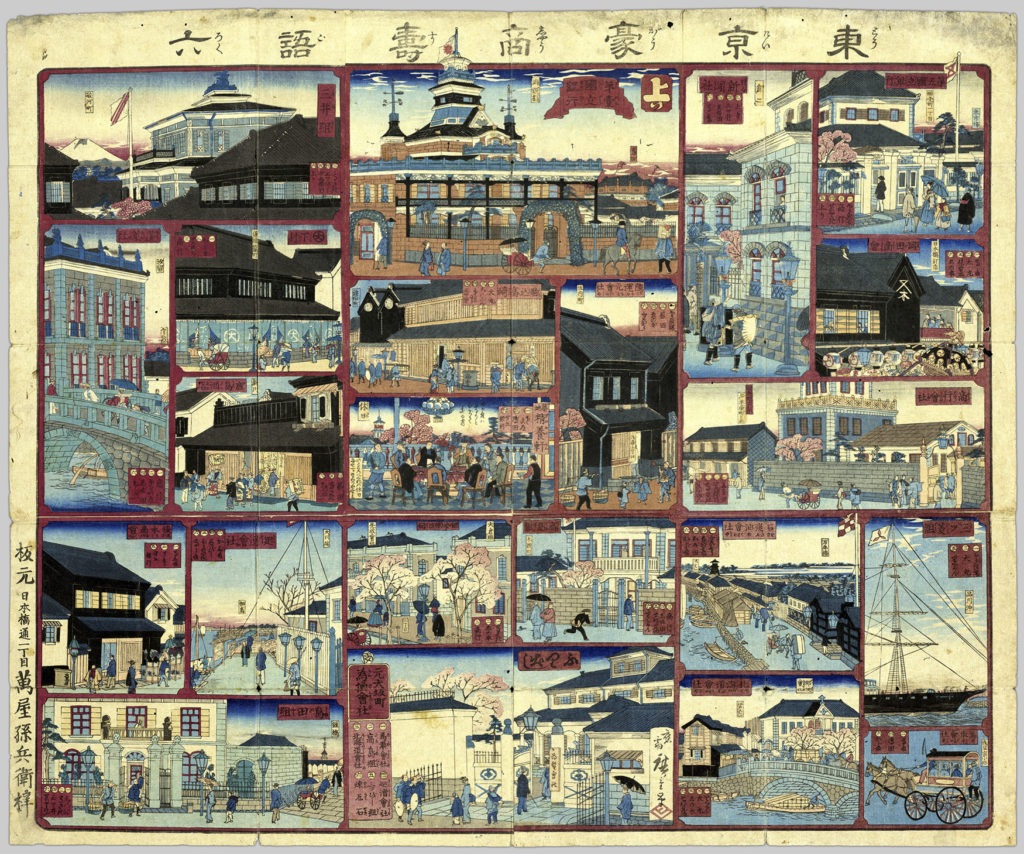
This image drawn by Utagawa Hiroshige III is an e-sugoroku, or “picture board game,” depicting Tokyo in the early Meiji Period (1868-1912). Sugoroku are Japanese board games similar to those seen around the world: players roll a dice to advance from the start (furidashi) square through a series of squares around the board. The player who reaches the end square (agari) first is the winner. In Japan, the development of printing technology from the middle of the Edo Period (1600-1868) made possible the publication of various form of so-called e-sugoroku, combining board games with graphic images.[1] Classifications of e-sugoroku are as varied as the types of board games themselves, but Takahashi Junji has categorized the Tōkyō Gōshō Sugoroku as one of many “enlightenment board games” (kaika sugoroku) illustrating the “civilization and enlightenment” (bunmei kaika) of the early-Meiji Period.[2] Still, the Tōkyō Gōshō Sugoroku also portrays traditional buildings retained from the Edo period right alongside the Western architecture that symbolized “civilization and enlightenment” during the Meiji period. In this way, Western and Japanese architectural forms mixed in the urban space of Tokyo during the early years of the city’s modern period. The Westernization of the city was at first pushed by the central government, but was later adopted by local residents as a place to experience a novel urban space by the end of the Meiji Period. By mapping what buildings were erected at which locations, we can locate the early-Meiji Tokyo urban layout and lot division patterns inherited from Edo. Thus, through a close reading of the architectural forms depicted on the Tōkyō Gōshō Sugoroku, this essay offers a glimpse of the traces of Edo urban space in early-Meiji Tokyo.
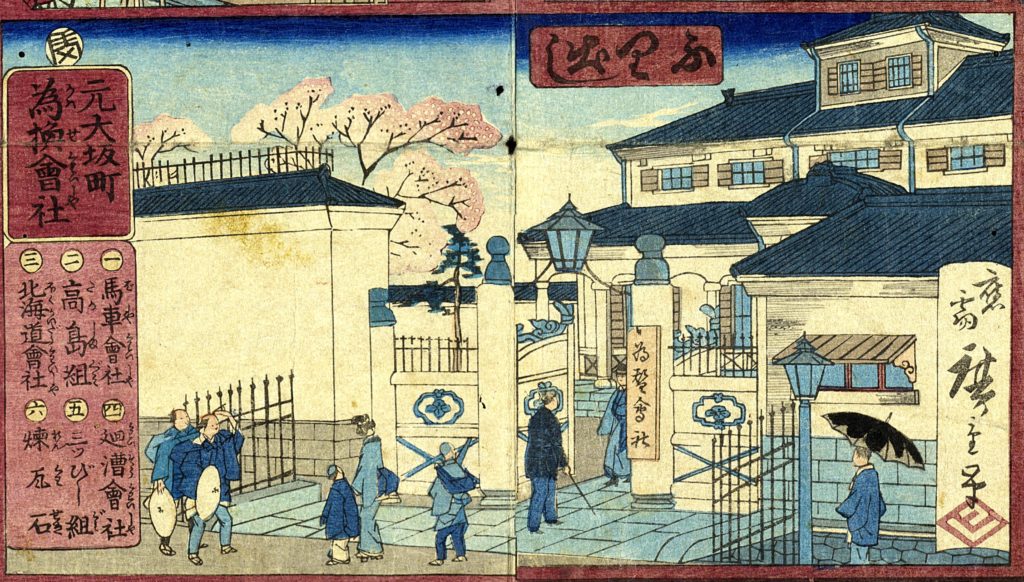
First, a detailed look at the Tōkyō Gōshō Sugoroku. In each of the game squares, we can see a number of building types no longer present in Tokyo – castellated buildings, roofs adorned with mythical sea creatures (shachi), or the plastered warehouses and Western-style brick buildings lining the Ginza. Labels identify the names and addresses of companies new to Tokyo at the time. Starting from the Kawase Gaisha commercial exchange in the bottom-central furidashi square, players roll the dice to reach the First National Bank in the agari square at the top-center. Notice the label in the Kawase Gaisha square locating the building in Moto-Ōsakachō [Figure 1], a commoners’ neighborhood from the Edo-period that disappeared in 1933 as part of the Imperial Capital Reconstruction Project following the Great Kantō Earthquake (now part of Nihonbashi Ningyōchō). A number of theories exist for the origin of the neighborhood’s name, but it is thought it derives from the granting of the land to merchants who moved from Ōsaka during the Tenshō Era (1573-1592), with “Moto” added to distinguish the area from nearby Shin-Ōsakachō (now Nihonbashi Tomizawachō).[3]During the Edo Period, the urban space of Edo was made up primarily of samurai areas (bukechi), commoner areas (chōninchi), and temple and shrine lands (jishachi). According an 1869 survey, bukechi made up 68.6%, or 9,585 acres, of the urban area of Edo, with the remainder split evenly between chōninchi (15.8%) and jishachi (15.6%).[4] It is possible, moreover, to roughly define a typical pattern of buildings that would have stood in each of these areas.
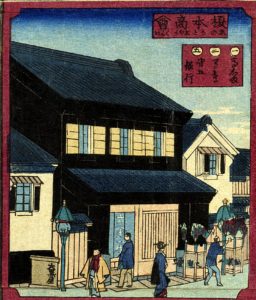
To this point, notice the layout of the buildings. Following the precedent of Edo-period samurai areas, the buildings are set far back from the street-front gate, allowing the gate to completely obscure the front entrance of the building. Bukechi lands were granted exclusively to warriors by the Tokuagawa Shogunate and varied in size, but most followed the basic layout of gradual stages passing from the street through a main gate into the compound and to a special guest entrance into the residence. In Edo commoners’ areas, on the other hand, storefronts faced directly onto the street with no gates, allowing direct entry into the building. On the Tōkyō Gōshō Sugoroku, both the Enomoto Kaisha and the Kajima Sakadana are of this type. In this way, by looking at the layout of buildings, it is possible to define a typical pattern of Edo-period compounds. But this would mean that in the case of the Kawase Gaisha a building with a bukechi layout was erected in a former chōninchi lot.
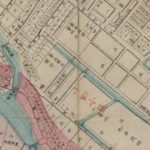
Now, why is it that the Kawase Gaisha has a bukechi layout in the commoners’ area of Moto-Ōsakachō? In fact, this neighborhood had originally been a bukechi. In the detail of the 1874 Tōkyō Zenzu in Figure 3, we can see a marker for Tōkyō Kawase Gaisha in the centre-upper right in a plot that is quite large compared to the neighboring properties. In reality, the Tōkyō Kawase Gaisha was not in Moto-Ōsakachō at all, but instead in the 2-chōme block of Kakigarachō. Next let’s take a look at the 1859 Owariya kiriezu in Figure 4, depicting the areas to the south of those seen in Figure 3. On this kiriezu, we see the name “Ginza” denoting the location of the silver mint later replaced by the Tōkyō Kawase Gaisha during the Meiji Period. The reason the district known as Ginza today is located to the southwest of the “Ginza” shown in Figure 4 is that the mint had been relocated to this area in 1800 as a result of worsening management and incidents of illegal activity.[5] At this time, the mint was under the direct control of the Tokugawa Shogunate’s finance magistrate (kanjō bugyō). The whole of Moto-Ōsakachō and the areas across the street were all bukechi with many Daimyō compounds. During the Edo period, bukechi neighborhoods did not have names, and the name Kakigarachō was not fixed until the tenth month of 1871.[6]
So, why is the neighborhood in the Tōkyō Gōshō Sugoroku listed as Moto-Ōsakachō? The key to unlocking this question lies in the fact that in the decades prior to the scene depicted in the Figure 4 kiriezu, just over 1 acre of land was added to Ginza in the ninth month of 1842.[7] Referring to the 1840 Go-funai enkaku zusho map that allows us to trace changes in Edo land usage patterns, we see that the areas subsumed into Ginza are labeled Moto-Ōsakachō [Figure 5] since Edo was made up of neighborhoods in which one name referred to areas on both sides of the street. But in this case, since one half of the street was subsumed into Ginza, we know that Moto-Ōsakachō only referred to one side of the street. Because the commoner’s district of Moto-Ōsakachō was incorporated into Ginza, the name of Moto-Ōsakachō is listed in the caption on the Tōkyō Gōshō Sugoroku. Thus, the spatial characteristics of the Kawase Gaisha were inherited from the former bukechi. In much the same way, the First National Bank in the centre-top agari square, the Fifth National Bank in the top right square, or the Tokyo Grain Exchange (Tōkyō Shōkō Kaisha) in the right-middle all have the same spatial layout as the Kawase Gaisha. And as we can see in the kiriezu, they all were former bukechi prior to the Meiji Period. In the case of the First National Bank, the Shimada-gumi erected the building in the former compound of the Matsudaira governor of Izumi sold off by the government following the Meiji Restoration.
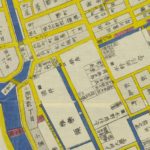
Next, let’s turn our attention to the rowhouse gates (nagayamon) lining the streets. Nagayamon denotes a rowhouse that includes a gate, a type of construction which for the most part only high-level samurai were permitted to build. In the case of Daimyō, soldiers would live in rowhouses on either side of the gate. In the Kawase Gaisha square on the Tōkyō Gōshō Sugoroku, we can see what at first appears to be a generic nagayamon with a window opening onto the street to the right of the gate. However, there are a number of unexpected things here. First, the gatepost. The gatepost in the image is exceptionally advanced for this time-period. Namely, the top of the pillar is ornamented with a spherical giboshi, a design not formally used for samurai compound gates. Instead, giboshi were a type of ornament seen originally in temple construction and bridge railings. Secondly, the curvature at the top of the gate. Until then, arches and curves were not often seen in a Japan with so much wooden construction. But we can see that the gate of the Kawase Gaisha has an arch with decorations on top. A gate of this same design can also be seen in Tokyo Grain Exchange (Tōkyō Shōkō Kaisha) square in the right-middle of the board. The First National Bank in the agari square also has an arched gate, indicating that such arches were symbols of Western architecture for carpenters at that time.
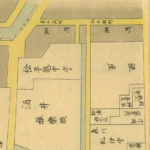
Although these Western-style buildings all feature arched windows, quoins, and classical entablature, it is clear at first glance that these are not genuine Western buildings. Constructed by Japanese carpenters, the Western-style buildings erected at this time were not made of stone as in the case of actual Western construction but were made of wooden frames and plastered with stone on the outer walls. In other cases, earthen walls were even made to look like stonework. First appearing in the early Meiji Period, this type of so-called “Pseudo-Western” (Giyōfū) architecture was built by Japanese carpenters following the example of Western-style buildings erected in the foreign settlement in Yokohama following the opening of the port in 1854.[8] It was Japanese carpenters employed in the construction of these buildings in the Yokohama foreign settlement who made it possible for Giyōfū architecture to blossom in Tokyo. The first bloom was surely none other than the 1872 First National Bank in the Tōkyō Gōshō Sugoroku’s agari square and popularized by the triptych by Shōsai Ikkei from the same year in Figure 6. The building was a five-story castle-style structure built through and through with Japanese architectural elements, but the bottom two stories were constructed with a design mimicking Western stone architecture. The compound interior, meanwhile, has a courtyard, and the building was divided into a number of small rooms laid out in the Japanese step-back (gankō) style because of its wooden construction, as planned and implemented by Japanese carpenter Shimizu Kisuke.[9]
While Western-style buildings began to be erected in former samurai areas as hoped for by a Meiji government intent on Westernization, buildings in former commoner areas with the exception of Ginza Bricktown largely remained plaster dozō-zukuri warehouses (for more on Ginza Bricktown, see essay by Tristan Grunow). Looking back from the early Meiji Period to the Edo Period allows us to see continuities in urban space. In the case of the Nihonbashi area, samurai and commoner areas were mixed in the urban space and were often side-by-side. As a result, the Giyōfū buildings of samurai areas and the plaster warehouses of commoner areas, too, were mixed throughout the city. Fires frequently razed commoner areas, with buildings erected only to be consumed by fires time and time again. Finally, in 1881, the Tokyo government issued fireproofing regulations, requiring buildings facing main streets to be built in brick, stone, or plaster. Structures erected following these new guidelines, however, continued to be plaster for the most part. Following the 1872 Ginza Fire and the construction of Ginza Bricktown, Western style buildings gradually began to appear in commoners’ areas. But it was not until the late Meiji Period that Western architecture came to be widespread in commoner areas.
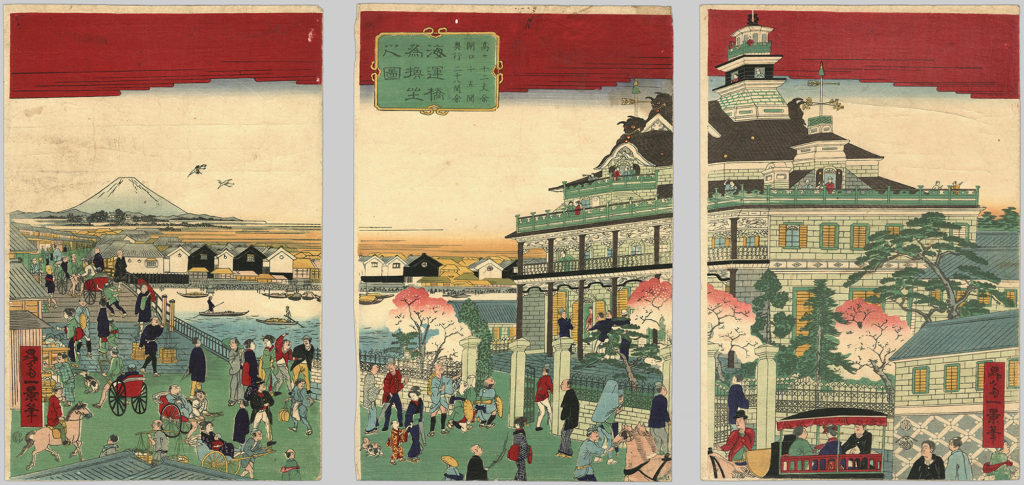
Even still, Western-style buildings erected in the late Meiji period in commoners’ areas were actually wooden, with a façade of plaster made to appear Western. The reason for this was that the people who most actively embraced the impact of “the West” in Tokyo were the skillful merchants who could profit from having a unique Western-style building to attract customers to their stores. As a result, vaguely “Western” streetscapes appeared in downtown areas like Ginza and Asakusa by the end of the Meiji period. The “West” that finally became most familiar to the general public in Tokyo, then, was a “West” that was already a misrepresentation, and it was not even until after the end of the Meiji Period that Western-style rooms began to appear in middle-class Japanese houses. By the 1910s, Western architecture and traditional plaster architecture of various designs chaotically mixed in a state of complete disorder throughout the city.[10]
The Meiji Government erected Western-style buildings to appeal to Western countries in the hopes of revising unequal treaties, requiring the construction of authentic Western architecture. That plan would come to fruition with the Rokumeikan, or “Deer Cry Pavilion,” completed in 1883. In other words, Government-sponsored buildings gradually transitioned from pseudo-Western Giyōfū architecture designed and constructed by Japanese carpenters or hired foreign advisors (oyatoi),[11] to more authentic Western architecture. Urban residents, on the other hand, commissioned Giyōfū-style structures from craftspeople who eagerly embraced Western cultural influences instead of rejecting them. As a result, new techniques adopting new forms without hesitation and allowing new and old forms to coexist began appearing in the urban space of Tokyo. The Tōkyō Gōshō Sugoroku gives us a visual depiction of this mixing of Western and Japanese styles in early Meiji Tokyo.
Translated by Tristan R. Grunow
Buildings and Locations Depicted in the Tōkyō Gōshō Sugoroku
- Moto-Ōsakachō – Kawase Gaisha
- Yoroibashi – Shimada-gumi
- Shin-izumichō – Enomoto Shōkai (Daikokuya)
- Ōkawabata – Kaisō Gaisha
- Shinkawa – Kajima Sakadana
- Shiodome – Hōraisha
- Surugachō – Mitsui-gumi
- Tōrihatagochō – Daimaru
- Tsukiji – Seiyōken
- Komagome – Takasakiya
- Sanaichō – Rikuun Motokaisha
- Ginza Sanchōme – Ōkura-gumi, Senshū Gaisha
- Kobikichō – Takashima-gumi
- Edobashi – Yūbin Kaisha (Hokkaidō Kaisha)
- Mannenbashi – Sekitan Abura Kaisha
- Asakusa Hirokōji – Basha Kaisha
- Shinagawa-oki – Mitsubishi-gumi
- Kakigarachō 2-chōme – Shōkō Kaisha
- Nihonbashi – Okada Shōkai
- Ginza – Nichi nichi Shinbun
- Kakigarachō 1-chōme – Daigo Kokuritsu Ginkō
- Kaiunbashi – Daiichi Kokuritsu Ginkō
- 加藤康子・松村倫子編著『幕末・明治の絵双六』国書刊行会、, 2002 ↵
- 高橋順二編著『日本絵双六集成』柏書房, 1980 ↵
- 東京市役所市史編纂『東京案内上巻』1986(1907年書肆裳華房の復刻版を用いた)、また、東京府が明治5年から7年にわたって行った調査(東京都『東京府史料1』1959)には「大坂の廻船此所まて入津せし故に大坂町と唱う」とある。 ↵
- 吉田伸之編「江戸の土地—大名・幕臣の土地問題」『日本の近世9』中央公論社, 1992 ↵
- 大石学『地名で読む江戸の町』PHP新書,2001、および[3] ↵
- 東京市日本橋区役所編纂『日本橋区史第一册』1916 ↵
- 東京市日本橋区役所編纂『日本橋区史第三册』1916 ↵
- 擬洋風建築の解説については藤森照信『日本の近代建築(上)-幕末・明治篇–』岩波新書,1993に詳しい。 ↵
- 初田亨『都市の明治—路上からの建築史』1981筑摩書房 ↵
- 前掲[9] ↵
- “Hired foreign advisors” (oyatoi) refers to foreigners hired by the Meiji government in the early Meiji period. Many of the foreigners hired relating to architecture were actually engineers rather than architects. ↵

